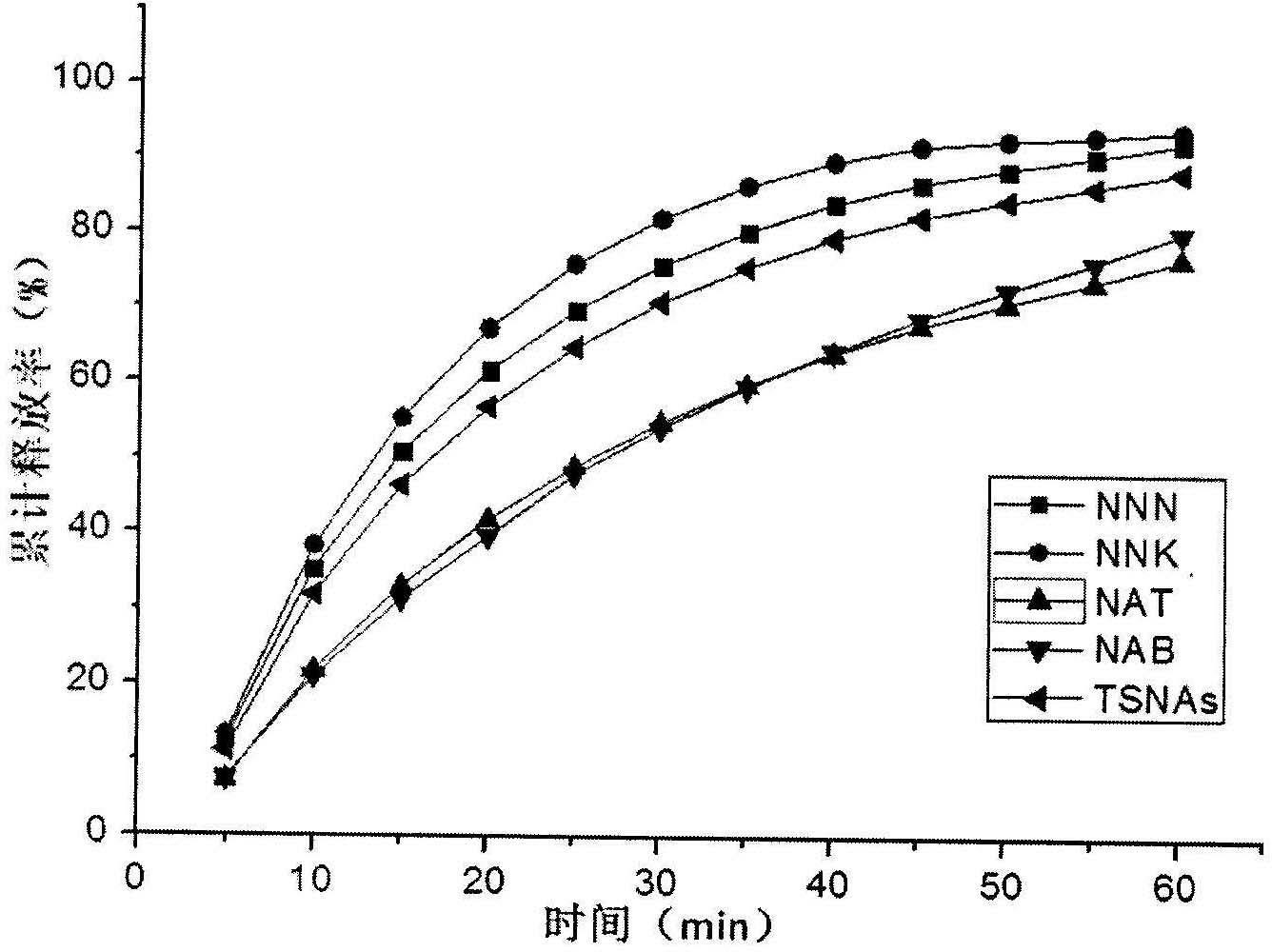Method for detecting release condition of tobacco specific nitrosamines in buccal tobacco product
A technology for tobacco products and nitrosamines, which can be used in measuring devices, instruments, scientific instruments, etc., can solve problems such as lack of technical methods, and achieve the effects of good repeatability and high sensitivity
- Summary
- Abstract
- Description
- Claims
- Application Information
AI Technical Summary
Problems solved by technology
Method used
Image
Examples
Embodiment 1
[0037] The flow rate was 0.2 mL / min, the temperature was 37°C, and the release medium was artificial saliva (pH 6.7); TSNAs in the release liquid and residual samples were determined by liquid chromatography-electrospray tandem mass spectrometry.
[0038] The liquid chromatography operating conditions and mass spectrometry detection parameters adopted by liquid chromatography-electrospray tandem mass spectrometry are:
[0039] HPLC parameters: Chromatographic column: Poroshell 120 SB-C18 (3.0 x 100 mm i.d., 2.7 μm, Agilent, USA); column temperature: 50.0 ℃; injection volume: 5 μL; flow rate: 0.30mL / min; mobile phase: A : water (containing 0.1% acetic acid, volume fraction), B: methanol (containing 0.1% acetic acid, volume fraction); pre-equilibration time: 5min; gradient elution conditions are as in the attached Table 1 above.
[0040] Mass spectrometry conditions: ion source: electrospray ionization source (ESI); scan mode: positive ion scan; detection method: multiple reacti...
Embodiment 2
[0043] The flow rate was 0.4mL / min, the temperature was 37°C, and the pH of the artificial saliva was 7.0; the detection of TSNAs in the released liquid was determined by liquid chromatography-electrospray tandem mass spectrometry, and the operating conditions of liquid chromatography and the detection parameters of mass spectrometry were the same. example 1.
[0044] Add artificial saliva with a pH of 7.0 to the solvent storage bottle, turn on the constant temperature tank and constant flow pump, and set the flow rate to 0.4 mL / min. After the system stabilizes to 37 °C, open the glass ground plug and place the sample flat On the stand, cover the ground stopper, and at the same time, collect once every 5 minutes for a total of 60 minutes. After the release solution is collected, take out the residual sample after release and put it into a 50 mL Erlenmeyer flask, add 0.2 mL of 2 μg / mL of internal standard solution (d 4 -NNK,d 4 -NNN,d 4 -NAB and d 4 -NAT mixed solution) an...
Embodiment 3
[0046] The flow rate was 0.2 mL / min for the first 5 minutes and 1 mL / min for the next 55 minutes, the temperature was 37 °C, and the pH of the artificial saliva was 7.0; the detection of TSNAs in its release liquid was performed by high performance liquid chromatography, and the chromatographic parameters were the same as in Example 1
[0047] Add artificial saliva with a pH of 7.0 to the solvent storage bottle, turn on the constant temperature tank and constant flow pump, set the flow rate to 1 mL / min, and after the system stabilizes to 37 °C, open the glass ground plug and place the sample flat Cover the sample holder with a ground stopper, and at the same time, collect once every 5 minutes for a total of 60 minutes. After the release solution is collected, take out the remaining sample after release and put it into a 50 mL Erlenmeyer flask, add 0.2 mL of 2 μg / mL internal standard solution (d 4 -NNK,d 4 -NNN,d 4 -NAB and d 4-NAT mixed solution) and 20 mL of 100 mM ammoni...
PUM
 Login to View More
Login to View More Abstract
Description
Claims
Application Information
 Login to View More
Login to View More - R&D
- Intellectual Property
- Life Sciences
- Materials
- Tech Scout
- Unparalleled Data Quality
- Higher Quality Content
- 60% Fewer Hallucinations
Browse by: Latest US Patents, China's latest patents, Technical Efficacy Thesaurus, Application Domain, Technology Topic, Popular Technical Reports.
© 2025 PatSnap. All rights reserved.Legal|Privacy policy|Modern Slavery Act Transparency Statement|Sitemap|About US| Contact US: help@patsnap.com



